11 - 13 July 2017. Geneva. Global Review 2017 of Aid for Trade, “Promoting Trade, Inclusiveness and Connectivity For Sustainable Development”.
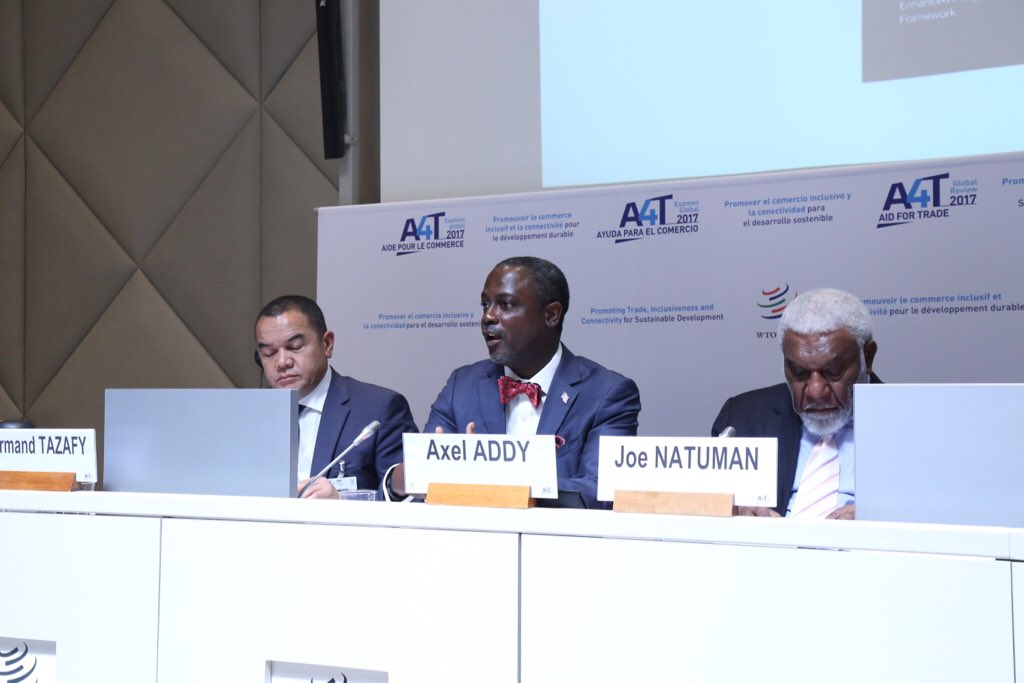 Underpinning the Review is a monitoring and evaluation (M&E) exercise. The aim of the M&E exercise is to survey: Aid-for-Trade priorities and how these have changed; the status of Trade Facilitation Agreement implementation and support; engagement in, and support to, the development of e-commerce; and infrastructure investment, the development of related services markets and related investment climate reforms.
Underpinning the Review is a monitoring and evaluation (M&E) exercise. The aim of the M&E exercise is to survey: Aid-for-Trade priorities and how these have changed; the status of Trade Facilitation Agreement implementation and support; engagement in, and support to, the development of e-commerce; and infrastructure investment, the development of related services markets and related investment climate reforms.
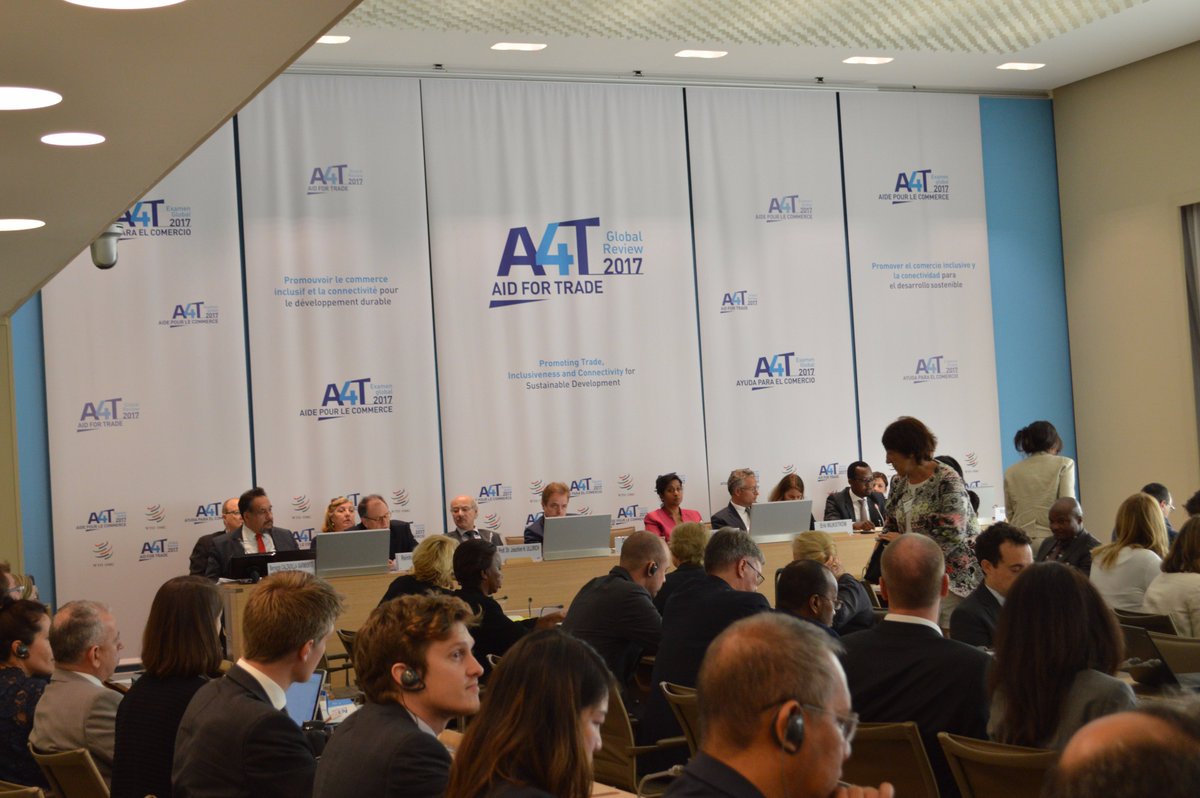 The Aid for Trade Global Review 2015 highlighted how high trade costs slow growth and development by pricing many suppliers in developing and least developed countries out of global markets. The 2017 Global Review develops this theme further by extending analysis of trade costs into the area of digital connectivity. The Review will discuss the economic consequences of the digital divide and strategies to help policymakers, firms, women and SMEs to bridge this divide.
The Aid for Trade Global Review 2015 highlighted how high trade costs slow growth and development by pricing many suppliers in developing and least developed countries out of global markets. The 2017 Global Review develops this theme further by extending analysis of trade costs into the area of digital connectivity. The Review will discuss the economic consequences of the digital divide and strategies to help policymakers, firms, women and SMEs to bridge this divide.
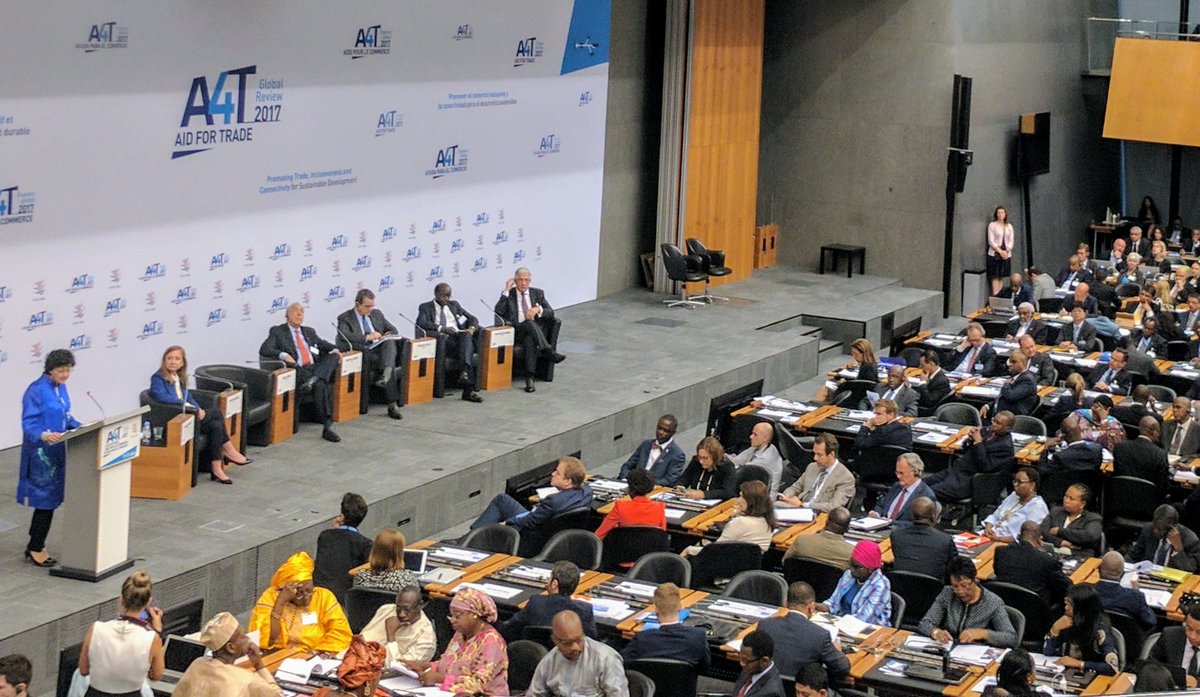 One tool at the disposal of trade policymakers to reduce logistics trade costs is the WTO Trade Facilitation Agreement (TFA) that entered into force on 22 February2015 World Trade Report outlined the inclusive trade outcomes that may be achieved though trade facilitation reforms. This issue will be further examined during the 2017 Global Review.
One tool at the disposal of trade policymakers to reduce logistics trade costs is the WTO Trade Facilitation Agreement (TFA) that entered into force on 22 February2015 World Trade Report outlined the inclusive trade outcomes that may be achieved though trade facilitation reforms. This issue will be further examined during the 2017 Global Review.
2017. The
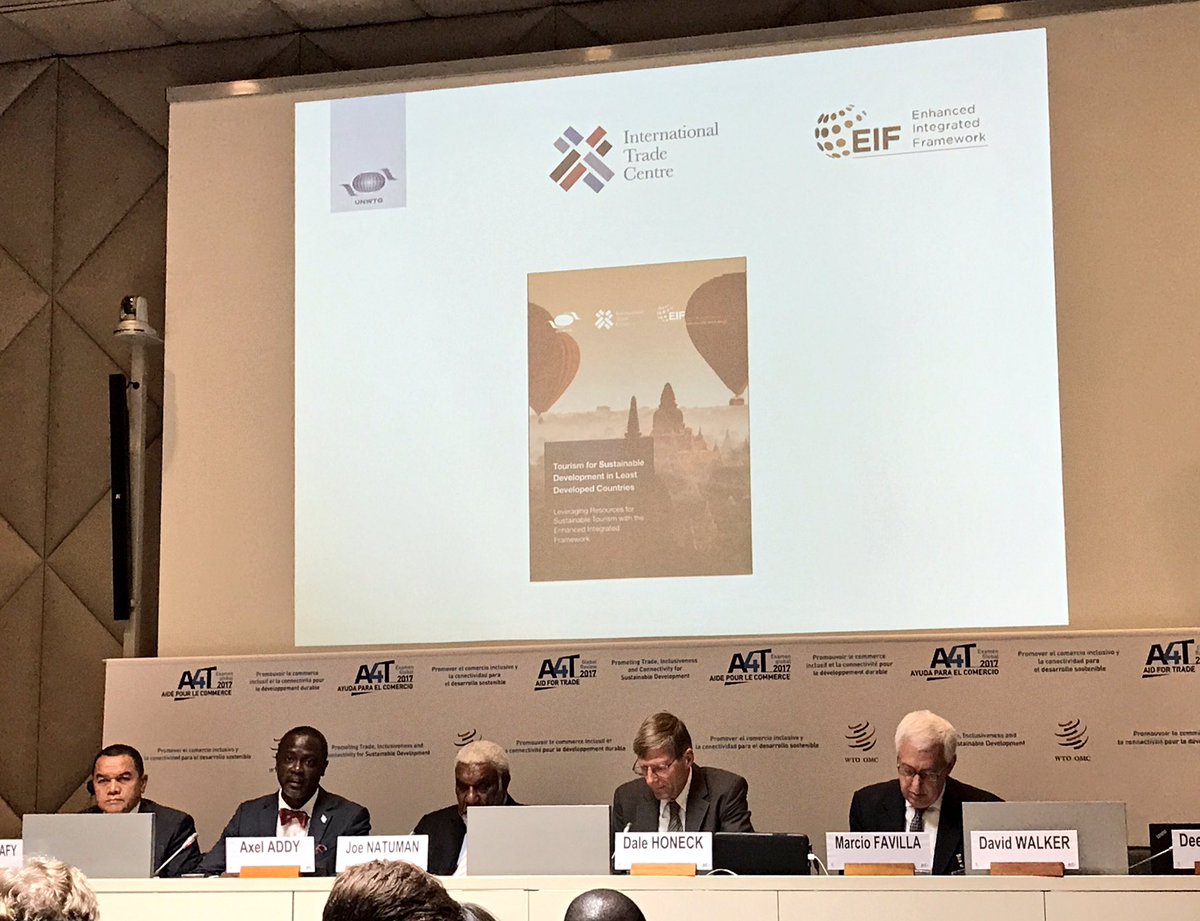 Discussions will be informed by the Aid for Trade at a Glance report, published jointly by the World Trade Organization and the Organisation for Economic Co-operation and Development, with contributions from Business for eTrade Development, the Enhanced Integrated Framework, the International Telecommunications Union, the International Trade Centre, the United Nations Conference on Trade and Development and the World Bank Group. Additional analysis will be contributed by regional development banks and other stakeholders.
Discussions will be informed by the Aid for Trade at a Glance report, published jointly by the World Trade Organization and the Organisation for Economic Co-operation and Development, with contributions from Business for eTrade Development, the Enhanced Integrated Framework, the International Telecommunications Union, the International Trade Centre, the United Nations Conference on Trade and Development and the World Bank Group. Additional analysis will be contributed by regional development banks and other stakeholders.
Below video starts @ the 40th min'
 Underpinning the Review is a monitoring and evaluation (M&E) exercise. The aim of the M&E exercise is to survey: Aid-for-Trade priorities and how these have changed; the status of Trade Facilitation Agreement implementation and support; engagement in, and support to, the development of e-commerce; and infrastructure investment, the development of related services markets and related investment climate reforms.
Underpinning the Review is a monitoring and evaluation (M&E) exercise. The aim of the M&E exercise is to survey: Aid-for-Trade priorities and how these have changed; the status of Trade Facilitation Agreement implementation and support; engagement in, and support to, the development of e-commerce; and infrastructure investment, the development of related services markets and related investment climate reforms. The Aid for Trade Global Review 2015 highlighted how high trade costs slow growth and development by pricing many suppliers in developing and least developed countries out of global markets. The 2017 Global Review develops this theme further by extending analysis of trade costs into the area of digital connectivity. The Review will discuss the economic consequences of the digital divide and strategies to help policymakers, firms, women and SMEs to bridge this divide.
The Aid for Trade Global Review 2015 highlighted how high trade costs slow growth and development by pricing many suppliers in developing and least developed countries out of global markets. The 2017 Global Review develops this theme further by extending analysis of trade costs into the area of digital connectivity. The Review will discuss the economic consequences of the digital divide and strategies to help policymakers, firms, women and SMEs to bridge this divide. One tool at the disposal of trade policymakers to reduce logistics trade costs is the WTO Trade Facilitation Agreement (TFA) that entered into force on 22 February2015 World Trade Report outlined the inclusive trade outcomes that may be achieved though trade facilitation reforms. This issue will be further examined during the 2017 Global Review.
One tool at the disposal of trade policymakers to reduce logistics trade costs is the WTO Trade Facilitation Agreement (TFA) that entered into force on 22 February2015 World Trade Report outlined the inclusive trade outcomes that may be achieved though trade facilitation reforms. This issue will be further examined during the 2017 Global Review.2017. The
 Discussions will be informed by the Aid for Trade at a Glance report, published jointly by the World Trade Organization and the Organisation for Economic Co-operation and Development, with contributions from Business for eTrade Development, the Enhanced Integrated Framework, the International Telecommunications Union, the International Trade Centre, the United Nations Conference on Trade and Development and the World Bank Group. Additional analysis will be contributed by regional development banks and other stakeholders.
Discussions will be informed by the Aid for Trade at a Glance report, published jointly by the World Trade Organization and the Organisation for Economic Co-operation and Development, with contributions from Business for eTrade Development, the Enhanced Integrated Framework, the International Telecommunications Union, the International Trade Centre, the United Nations Conference on Trade and Development and the World Bank Group. Additional analysis will be contributed by regional development banks and other stakeholders.Below video starts @ the 40th min'
SESSION 11 : REGIONAL FOCUS
Promoting Connectivity In Africa – The Role of Aid for Trade in Boosting Intra-African Trade
This regionally focused plenary session will launch the United National Economic Commission for Africa report on "Promoting Connectivity in Africa – the Role of Aid for Trade in Boosting Intra-African Trade". Discussions shall be based on how promoting connectivity can contribute to the implementation of Africa’s regional integration, notably in the context of the Action Plan for Boosting-intra African Trade.
Moderator: Uzo Madu, Founder, What's in it for Africa?
Panel discussion:
- Vera Songwe, Executive Secretary, United Nations Economic Commission for Africa
- Pierre Guislain Vice-President for Private Sector, Infrastructure and Industrialization, African Development Bank
- Albert M. Muchanga, Commissioner for Trade and Industry, African Union Commission
- Benedict Okey Oramah, President and Chairman, African Export – Import Bank
- Joakim Reiter, Group External Affairs Director, Vodafone
- Christopher Thornley, High Commissioner to Nigeria, Canada
Gender features strongly as a cross-cutting theme in the "Aid for Trade at a Glance 2017" report. It highlights that developing countries and their development partners increasingly recognize the economic growth potential that can be tapped through women's economic empowerment. Among the 40 donors surveyed, 87% indicated that they now integrate women's economic empowerment into their Aid for Trade programming. And with good reason. The report also underscores a series of divides that hamper women and women-owned firms from fully reaping the benefits of international trade.
Divides in terms of access to information and skills needed to export; access and use of technology that helps integrate into global and regional value chains; and ownership or management of firms still exist. Research shows that the productivity premium that firms derive from exporting is actually lower for women-owned firms. When women-owned firms face the same barriers to trade as men-owned firms, they find them more costly to overcome. As firm size increases, obstacles grow, keeping the exporting firms owned or managed by women small. New technology, online platforms and e-commerce can help, but women entrepreneurs still run up against gender-based barriers that reduce their productivity and often their commercial viability.
Progress has been made in integrating gender into Aid for Trade programming. But there is still much room for improvement. Only 38% of developing countries felt that Aid for Trade could contribute to the gender equality target found in SDG 5 of the 2030 Agenda for Sustainable Development – as compared to 50% of donor respondents.
The session WAS organized around the following themes:
Moderator: Vanessa Erogbogbo, Head of Women and Trade Programme, International Trade Centre
Panel discussion:
Divides in terms of access to information and skills needed to export; access and use of technology that helps integrate into global and regional value chains; and ownership or management of firms still exist. Research shows that the productivity premium that firms derive from exporting is actually lower for women-owned firms. When women-owned firms face the same barriers to trade as men-owned firms, they find them more costly to overcome. As firm size increases, obstacles grow, keeping the exporting firms owned or managed by women small. New technology, online platforms and e-commerce can help, but women entrepreneurs still run up against gender-based barriers that reduce their productivity and often their commercial viability.
Progress has been made in integrating gender into Aid for Trade programming. But there is still much room for improvement. Only 38% of developing countries felt that Aid for Trade could contribute to the gender equality target found in SDG 5 of the 2030 Agenda for Sustainable Development – as compared to 50% of donor respondents.
The session WAS organized around the following themes:
- How can Aid for Trade help developing countries integrate gender into their development policies? How should the trade dimension be captured?
- How best should development partners align their support with the national and regional frameworks of the governments they seek to support so as to achieve maximum impact, notably in terms women's economic empowerment?
- What is the role of the private sector? How can it be involved through advocacy, action and adherence to globally agreed rules?
- How can gender empowerment action pursued through the Aid for Trade address broader issues of poverty and inequality, without losing sight of the trade dimension?
Moderator: Vanessa Erogbogbo, Head of Women and Trade Programme, International Trade Centre
Panel discussion:
- Ann Linde, Minister for European Union Affairs and Trade, Sweden
- Armand Tazafy, Minister of Commerce, Madagascar
- Isatou Touray, Minister of Trade, The Gambia
- Hiroshi Kuniyoshi, Deputy to the Director General, United Nations Industrial Development Organization
- Anabel Gonzalez, Senior Director, Trade and Competitiveness Global Practice, Trade & Competitiveness, World Bank Group
- Candace Nkoth Bisseck, Founder, Digital for Development, and Consultant, Stanford Seed West Africa
SESSION 32 : SIDE EVENT
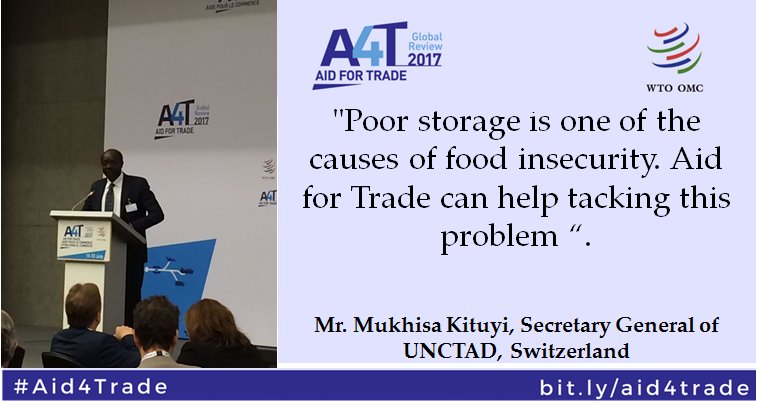 Connecting Trade and Agricultural Development in the LDCs
Connecting Trade and Agricultural Development in the LDCs Agriculture is a critical component of Aid for Trade and the largest contributor within productive capacity, contributing on average between 15% and 20% of all Aid-for-Trade flows. This should not be surprising given the importance of agriculture to trade in LDCs, a sector providing 69% of total employment, with half being women (UNCTAD).
Despite the synergic linkages between trade and agriculture in development, clear opportunities exist to better link agriculture and trade policy, processes and programmes in LDCs. For instance, the Comprehensive Africa Agriculture Development Programme (CAADP) of the African Union and the Enhanced Integrated Framework (EIF) provide institutional, policy and programming mechanisms for both agriculture and trade in African LDCs.
The Food and Agriculture Organization (FAO) has recently started a project in conjunction with the EIF and the European Centre for Development Policy Management (ECDPM) to pilot an approach to better connect the CAADP and EIF processes and improve the cross-sectoral linkages in four countries Mozambique, Rwanda, Tanzania and Zambia.
This workshop on "Connecting trade and agricultural development in LDCs" therefore aims to share the initial results of the project, and open the discussion to participants to explore the connections between agriculture and trade in development. The key themes will focus on collaboration, connecting siloes in agriculture and trade.
Moderator: Sean Woolfrey, The European Centre for Development Policy Management
Opening address:
- José Graziano da Silva, Director-General, Food and Agriculture Organization of the United Nations
- François Kanimba, Minister of Trade, Industry and Economic Affairs, Rwanda
- Ratnakar Adhikari, Executive Director, Enhanced Integrated Framework Secretariat
- Komla Bissi, The Comprehensive Africa Agriculture Development Programme, African Union Commission
- What is the role of trade within CAADP?
- Patterson Brown, USAID, Chair of the CAADP Donor Partners Coordination Group (DPCG): Enhancing connection with trade within the CAADP structure.
- What is being done to support better coordination amongst donor programming supporting trade and agriculture?
- Kayula Siame, Permanent Secretary, Ministry of Commerce, Trade and Industry, Zambia.
- What gaps have you identified (results of the analysis), and how are you planning to address them (results of dialogue)

Trade and Food Standards: Joint FAO-WTO Publication Launch
Trade in food is difficult to imagine without standards. Food standards give confidence to consumers about the safety, quality and authenticity of what they eat. By setting out a common understanding on different aspects of food for consumers, producers and governments, harmonization on the basis of international standards makes trade less costly and more inclusive. Food standards and trade go hand in hand in ensuring safe, nutritious and sufficient food for a growing world population.
Together, FAO and the WTO provide governments with the means to establish a framework to facilitate trade on the basis of internationally agreed food standards. Through the joint FAO/WHO Codex Alimentarius Commission, governments establish global science-based food standards that provide the foundation for achieving public health objectives such as food safety and nutrition. Since standards are essential for smooth trade, the WTO SPS and TBT Agreements strongly encourage governments to harmonize their requirements on the basis of international standards.
This publication emphasizes the importance of participation and engagement of governments in standards development in Codex and in resolving trade concerns in the WTO SPS and TBT Committees, as well as the importance of capacity development, which together contribute to the dynamism and robustness of the global system of food standards and trade.
Keynote addresses:
- Roberto Azevêdo, Director-General, World Trade Organization
- José Graziano da Silva, Director-General, Food and Agriculture Organization of the United Nations
SESSION 55 : SIDE EVENT Book Launch: Trade and the Sustainable Development Goals: Achieving Win-Wins
The recently agreed Sustainable Development Goals (SDGs) are expected to guide development through the 2030 time horizon. The 17 SDGs cover many areas, such as poverty, health, sustainable development, and the environment; however, there is no specific SDG trade goal. The objective of this book is to demonstrate to the international development community, including policymakers in developing countries, the contribution that international trade can make to achieving the SDGs. This book maps out a triple-win scenario: when good trade policy spurs international trade, contributes to development-friendly outcomes, and supports achieving the SDGs.
Presentations:
Presentations:
- Matthias Helble, Senior Economist, Asian Development Bank Institute
- Frans Lammersen, Principal Administrator, Development and Co-operation Directorate, Organisation of Economic Co-operation and Development
- Aik Hoe Lim, Director, Trade and Environment Division, World Trade Organization
- Ben Shepherd, Principal, Developing Trade Consultants



No comments:
Post a Comment